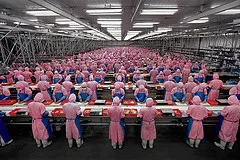
China’s flash manufacturing PMI rises to 49.8% in August
HSBC says recent export growth was strong, with shipments expanding by 22% y-o-y in 2Q.
The country’s economy is expected to grow by around 9% for the year as a whole.
Here’s more from HSBC:
| The flash manufacturing PMI reading picked up slightly to a level close to the breakeven level in August, which is still consistent to around 13% y-o-y IP growth. Despite on-going turmoil in global financial markets, the new exports orders sub- index rose to a three-month high, albeit still marginally below 50. All these suggest that risks of a hard landing risk are still remote, so providing more leeway for the PBoC to keep current tightening measures in place. Facts: Growth momentum, as measured by the difference between new orders and finished goods inventory sub-components, remained relatively weak - with the decline in the former outweighing the increase in the latter. That said, the absolute level of this gauge (1.4 in August vs. 1.9 in July) was still much better than the negative 4.4 back in July 2010 and negative double digit print in November-December 2008. More importantly, the raw material inventory sub-index saw a less sharp decline thanks to an increase in the quantity of purchase sub- index. This, plus the smaller decline in the job hiring sub-index (49.8 in August vs. 49.4 in July), suggests that manufacturers remain optimistic about the future business. On the inflation front, the output price sub-index rebounded to 52.1 in August from 50.5 in July while the input price sub-index edged up marginally to 54 in August from 53.9 in July. Although both readings are still below the series' long term average, this pick-up reminds us that inflationary pressures have yet to ease meaningfully; so any loosening of monetary policy may still invite a rebound in price pressures. Implications: Although marginally lower than the break-even level, August's flash reading remains close to the 50 no change mark, which is consistent with an industrial production growth rate of around 13% y-o-y. As such, it implies that China's IP growth will likely moderate to around 13% y-o-y in the months ahead, compared to 14% y-o-y in July, as domestic demand continues to soften in response to Beijing's on-going credit tightening measures. Such a pace is still fully consistent with 9%, or slightly Despite the downside risks posed by an increasingly uncertain outlook for Western demand, China's recent exports growth was strong. Shipments expanded by 22% y-o-y in 2Q despite sluggish US growth of around 1.3% q-o-q annualised for the same Going forwards, exports will likely trend lower for the rest of this year. That said, we believe net exports should not pose a significant drag on GDP growth given that a) China's growth in the post crisis era has been mainly driven by domestic demand, net exports was only a marginal contributor in 1H this year; b) imports growth will likely slow in tandem with domestic demand, keeping the trade surplus relatively stabilised. We are still expecting the economy to grow by around 9% for the year as a whole, despite Beijing's ongoing credit tightening at home and turmoil in markets overseas. A slowdown from an almost 10% growth rate in 4Q10-1Q11 to around 8.5-9% in 2H would be helpful for containing inflation, which will stay elevated despite having likely peaked in July. With risks of a hard landing still remote, PBoC can afford to keep current quantitative tightening measures in place. Bottom line: Growth in China is moderating, not collapsing. Inflation, not growth, remains the top near-term macro risk for policy makers. As such, PBoC tightening is not over yet. |
Photo from caffeineguy



![SBR 5 Lorem Ipsum News 2 [8 May]](https://cmg-qa.s3.ap-southeast-1.amazonaws.com/s3fs-public/styles/exclusive_featured_article/public/2025-05/a_hand_pointing_to_a_futuristic_technology_5b87c9d0e3_3.png.webp?itok=M3Hf-9XR)
![SBR 4 Lorem Ipsum [8 May Top Stories]](https://cmg-qa.s3.ap-southeast-1.amazonaws.com/s3fs-public/styles/exclusive_featured_article/public/2025-05/a_hand_pointing_to_a_futuristic_technology_5b87c9d0e3_2.png.webp?itok=2m5Wl0MX)


![Exclusive three SBR 12 Lorem Ipsum [8 May]](https://cmg-qa.s3.ap-southeast-1.amazonaws.com/s3fs-public/styles/exclusive_featured_article/public/2025-05/a_hand_pointing_to_a_futuristic_technology_5b87c9d0e3_11.png.webp?itok=8kn_UIfA)
![SBR 3 Lorem Ipsum [ Exclusive 2]](https://cmg-qa.s3.ap-southeast-1.amazonaws.com/s3fs-public/styles/exclusive_featured_article/public/2025-05/a_hand_pointing_to_a_futuristic_technology_5b87c9d0e3_1.png.webp?itok=YCyjLegJ)
![SBR 2 Lorem Ipsum [8 May]](https://cmg-qa.s3.ap-southeast-1.amazonaws.com/s3fs-public/styles/exclusive_featured_article/public/2025-05/a_hand_pointing_to_a_futuristic_technology_5b87c9d0e3_0.png.webp?itok=_cKD-29o)

![Video [Event News]](https://cmg-qa.s3.ap-southeast-1.amazonaws.com/s3fs-public/styles/event_news_featured_article/public/2025-05/screenshot-2025-05-08-at-4.58.53-pm_0.png.webp?itok=Kud35sMs)
![Event News SBR 9 Lorem Ipsum [8 may]](https://cmg-qa.s3.ap-southeast-1.amazonaws.com/s3fs-public/styles/event_news_thumbnail/public/2025-05/a_hand_pointing_to_a_futuristic_technology_5b87c9d0e3_8.png.webp?itok=DTh_dbYp)
![Event News SBR 9 Lorem Ipsum [8 May]](https://cmg-qa.s3.ap-southeast-1.amazonaws.com/s3fs-public/styles/event_news_thumbnail/public/2025-05/a_hand_pointing_to_a_futuristic_technology_5b87c9d0e3_7.png.webp?itok=vzDAzb6V)
![Event News SBR 8 Lorem Ipsum [8 May]](https://cmg-qa.s3.ap-southeast-1.amazonaws.com/s3fs-public/styles/event_news_thumbnail/public/2025-05/a_hand_pointing_to_a_futuristic_technology_5b87c9d0e3_6.png.webp?itok=jvHFc4P6)
![Video [Event News]](https://cmg-qa.s3.ap-southeast-1.amazonaws.com/s3fs-public/styles/video_thumbnail/public/2025-05/screenshot-2025-05-08-at-4.58.53-pm_0.png.webp?itok=yZnI0YBb)
![Video 1 SBR [8 May]](https://cmg-qa.s3.ap-southeast-1.amazonaws.com/s3fs-public/styles/video_thumbnail/public/2025-05/screenshot-2025-05-08-at-4.58.53-pm.png.webp?itok=9AAeRz_k)

 Advertise
Advertise

